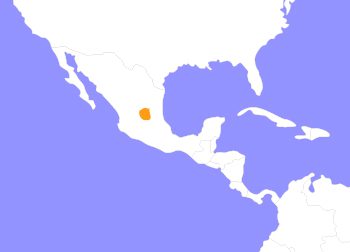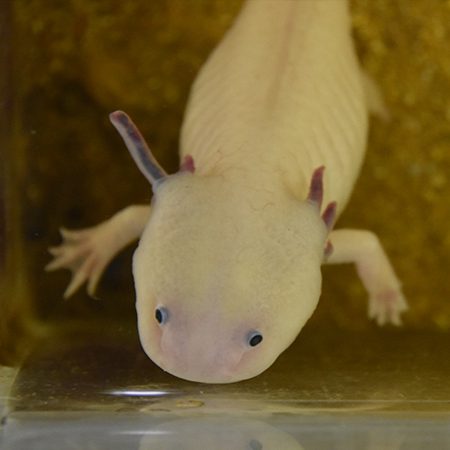Axolotl
Ambystoma mexicanum
Axolotls are members of the Salamander family. In fact, they are essentially just salamanders that decided to never grow up. This process is called neoteny, where an adult animal retains its juvenile characteristics. Amphibians are well known for their many life stages where they look completely different (think of a tadpole versus a full-grown frog). In the case of salamanders, they have external gills and a finned tail. When most salamanders reach maturity and move to live on land, they lose those characteristics, but not axolotls as they stay as fully aquatic amphibians throughout their life. Their weird looks have made them popular to keep as pets. They are also used as research animals for their ability to regenerate limbs.
Axolotls can be found in several colors, ranging from albino to a dark, almost brown or green color. They are very light, only weighing 2-4 oz and can reach almost a foot long. In captivity, axolotls tend to live 5-6 years. They are generally solitary in the wild outside of mating season, but can be housed together if given enough space. They are native to two lakes near Mexico City, Mexico, though one of those lakes has since disappeared.

Axolotl are native to Central America inhabiting Mexico.
HABITAT -Native to two high altitude lakes near Mexico City.
DIET -Being opportunistic carnivores, they will eat any fish, mollusk, or arthropod they can catch.
FUN FACT -Axolotls can detect electrical fields, which aids in finding prey.
SOCIAL BEHAVIOR -Generally solitary animals, they can live with others of the same species.
ACTIVITY -Axolotls are known to be active at any time of the day.
PREDATORS -Large and introduced fish species and even other axolotls.
SIZE -They are 2-4 oz and can almost a foot long (including their tail).
RELATIVES -Their closest living relative is the Plateau tiger salamander.
CONSERVATION -Axolotls have been listed as Critically Endangered because of habitat loss and predators.
Cub Creek Animal Care Information
Housing - Our axolotls are housed in a 30-gallon aquarium that has an external filter attached to continuously clean their water. Their tank is filled with artificial plants and various hides for them to explore. To simulate their natural environment, their water is kept chilled.
Diet - We feed our axolotls a special axolotl-specific pellet that contains fish, squid, and shrimp meals as well as vitamin and mineral supplements to make sure they get all the nutrients they need to be healthy. They are also given treats such as live worms that they love.
Enrichment - For enrichment, the axolotl tank can be rearranged to give them a new environment to explore. In the summer, our campers can create new hides out of plastic or terra cotta for them to play with as well.

